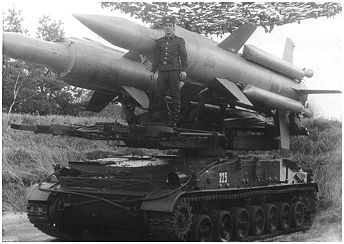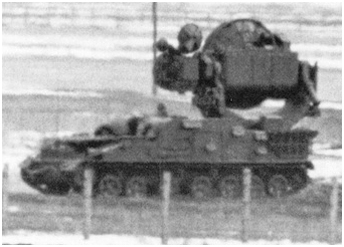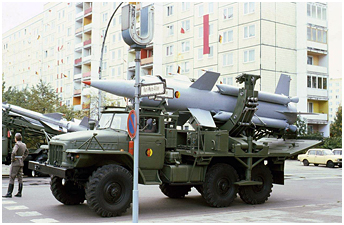 The system of anti-aircraft defense (Zenitnii Raketnii Kompleks - ZRK) 2K11 Krug (Circle) or SA-4 'Ganef' for NATO, was implementing
impressive 3M8 missiles mounted in pairs on a tracked self-propelled launcher 2P24. The launch ramps of the tractor-erector-launcher, or TEL
in military terms, could perform a full rotation of 360°.
The Krug was the first Soviet complex of anti-aircraft missile batteries that could be autonomously deployed on the battlefield.
The vehicles of that SAM system could be airlifted by An-22. Developed from
1958 on, the first model of the new missile entered service in 1965. The system was intended for division level area defence
against targets flying at medium and high altitudes, and it was deployed between 10 and 25 km from the forward edge of battle area (FEBA).
Although the missile is now obsolete - the Poles had nevertheless chosen to keep it until the summer of 2011 but we ignore for what reason -
it was a formidable weapon for its potential adversaries of the time.
The system of anti-aircraft defense (Zenitnii Raketnii Kompleks - ZRK) 2K11 Krug (Circle) or SA-4 'Ganef' for NATO, was implementing
impressive 3M8 missiles mounted in pairs on a tracked self-propelled launcher 2P24. The launch ramps of the tractor-erector-launcher, or TEL
in military terms, could perform a full rotation of 360°.
The Krug was the first Soviet complex of anti-aircraft missile batteries that could be autonomously deployed on the battlefield.
The vehicles of that SAM system could be airlifted by An-22. Developed from
1958 on, the first model of the new missile entered service in 1965. The system was intended for division level area defence
against targets flying at medium and high altitudes, and it was deployed between 10 and 25 km from the forward edge of battle area (FEBA).
Although the missile is now obsolete - the Poles had nevertheless chosen to keep it until the summer of 2011 but we ignore for what reason -
it was a formidable weapon for its potential adversaries of the time.
 Le radar de poursuite 1S32 "Pat Hand" déployé à Cochstedt en 1970. © P.Nikulla/USMLM.
Le radar de poursuite 1S32 "Pat Hand" déployé à Cochstedt en 1970. © P.Nikulla/USMLM.
The 1S32 'Pat Hand' tracking radar deployed at Cochstedt in 1970. © P.Nikulla/USMLM.
Judge by yourself: the missiles of the 2K11A Krug (1967) and 2K11M Krug-M (1971) systems flew at nearly 2,900 km/h, while those of 2K11M1
Krug-M1 (1974) system reached up to 3,600 km/h and the ceiling for each system was respectively from 250 to 23,500 meters, 250 to 24,500 meters and 150 to 24,500 meters!
The range was within a radius of 6 to 50 km.
That weapon was powered by four solid fuel boosters and a ramjet. After being launched at an angle of about 45 degrees, it turned
slowly on itself during the ascent to stabilize. The rocket boosters were dropped after nearly 15 seconds. That was the time necessary to reach a speed of Mach 1+
that was necessary for the proper operation of the ramjet. The 135 kg warhead of the missile was triggered by a proximity fuse.
Several variants of the 3M8 missile were developed. The one designated 3M8M2 or 3M8M3, had a shorter nose: that missile measured 8.3 meters long instead of 8.8 meters
for the other versions. It was optimized to hit targets over shorter distances.
 A typical SA-4 battery was composed of three 2P24 TEL armed with two missiles each, a vehicle equipped with a P-40/1S12 'Long Track' acquisition radar and a
vehicle equipped with a 1S32 'Pat Hand' tracking radar. The latter had the ability to guide two missiles on a single target if needed.
Each type of vehicle afore-mentioned was adapted on the same Metrovagonmash GM-123 tracked chassis.
2T6 missile resupply vehicles on the battlefield were based on trucks Ural-375 equipped
with a crane to carry and transload a single missile.
Batteries could also be integrated with the 9S44 Krab K-1 combat support system that was mounted on an Ural-375A chassis, which was intended to fuse data from multiple
acquisition radars to facilitate target tracking and battery control. These radars could be the P-10 'Knife Rest', P-12/18 'Spoon Rest', P-15/19 'Flat Face',
P-15M 'Squat Eye' and of course the P-40/1S12 'Long Track'.
A typical SA-4 battery was composed of three 2P24 TEL armed with two missiles each, a vehicle equipped with a P-40/1S12 'Long Track' acquisition radar and a
vehicle equipped with a 1S32 'Pat Hand' tracking radar. The latter had the ability to guide two missiles on a single target if needed.
Each type of vehicle afore-mentioned was adapted on the same Metrovagonmash GM-123 tracked chassis.
2T6 missile resupply vehicles on the battlefield were based on trucks Ural-375 equipped
with a crane to carry and transload a single missile.
Batteries could also be integrated with the 9S44 Krab K-1 combat support system that was mounted on an Ural-375A chassis, which was intended to fuse data from multiple
acquisition radars to facilitate target tracking and battery control. These radars could be the P-10 'Knife Rest', P-12/18 'Spoon Rest', P-15/19 'Flat Face',
P-15M 'Squat Eye' and of course the P-40/1S12 'Long Track'.
 |
Plan du site - Sitemap |  |
